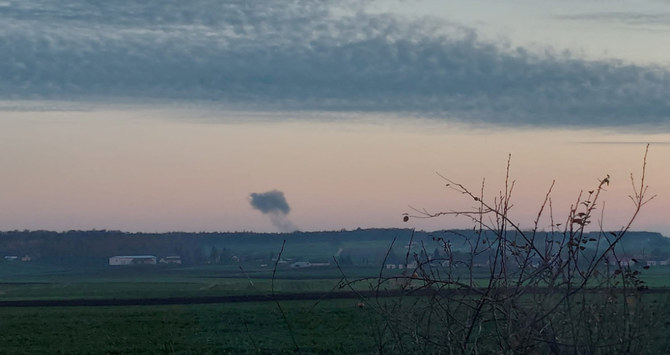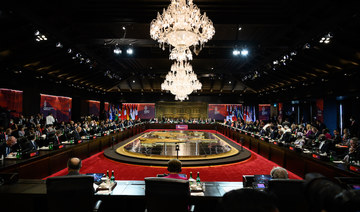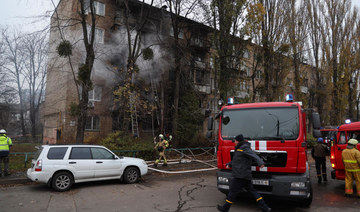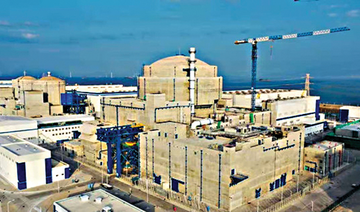KYIV: President Joe Biden convened an “emergency” meeting of the Group of Seven and NATO leaders in Indonesia Wednesday morning for consultations after NATO-ally Poland said a “Russian-made” missile killed two people in the eastern part of its country near the Ukraine border.
Biden, who was awakened overnight by staff with the news of the missile explosion while in Indonesia for the Group of 20 summit, called Polish President Andrzej Duda early Wednesday to express his “deep condolences” for the loss of life. Biden promised on Twitter “full U.S support for and assistance with Poland’s investigation,” and “reaffirmed the United States’ ironclad commitment to NATO.”
Meeting at a large round table in a ballroom in his hotel, the U.S. president hosted the leaders of the G-7, which includes Canada, France, Germany, Italy, Japan, the United Kingdom and the European Union, along with the president of the European Council and the prime ministers of NATO allies Spain and the Netherlands.
Biden replied “no” to reporters who asked if he would provide an update on the situation in Poland.
Poland said early Wednesday that a Russian-made missile fell in the eastern part of the country, killing two people in a blast that marked the first time in the war with Ukraine that Russian weapons came down on a NATO country.
Ukrainian President Volodymr Zelenskyy decried the strike as “a very significant escalation” of the war.
The Polish government said in a statement that Foreign Minister Zbigniew Rau summoned the Russian ambassador and “demanded immediate detailed explanations.”
Polish government spokesman Piotr Mueller said some military units were put on alert while officials sought details.
Polish media reported that the strike took place in an area where grain was drying in Przewodów, a village near the border with Ukraine.
The Russian Defense Ministry denied being behind “any strikes on targets near the Ukrainian-Polish border” and said in a statement that photos of purported damage “have nothing to do” with Russian weapons.
On Tuesday, Russia pounded Ukraine’s energy facilities with its biggest barrage of missiles yet, striking targets across the country and causing widespread blackouts.
The barrage also affected neighboring Moldova. It reported massive power outages after the strikes knocked out a key power line that supplies the small nation, an official said.
The missile strikes plunged much of Ukraine into darkness and drew defiance from Zelenskyy, who shook his fist and declared: “We will survive everything.”
In his nightly address, the Ukrainian leader said the reported strikes in Poland offered proof that “terror is not limited by our state borders.”
"We need to put the terrorist in its place. The longer Russia feels impunity, the more threats there will be for everyone within the reach of Russian missiles,” Zelenskyy said.
Russia fired at least 85 missiles, most of them aimed at the country's power facilities, and blacked out many cities, he said.
The Ukrainian energy minister said the attack was “the most massive” bombardment of power facilities in the nearly 9-month-old Russian invasion, striking both power generation and transmission systems.
The minister, Herman Haluschenko, described the missile strikes as “another attempt at terrorist revenge” after military and diplomatic setbacks for the Kremlin. He accused Russia of “trying to cause maximum damage to our energy system on the eve of winter.”
The aerial assault, which resulted in at least one death in a residential building in the capital, Kyiv, followed days of euphoria in Ukraine sparked by one of its biggest military successes — the retaking last week of the southern city of Kherson.
The power grid was already battered by previous attacks that destroyed an estimated 40% of the country’s energy infrastructure. Zelenskyy said the number of Ukrainians without power had fallen from 10 million to 2 million by Tuesday evening.
Russian President Vladimir Putin has not commented on the retreat from Kherson since his troops pulled out in the face of a Ukrainian offensive. But the stunning scale of Tuesday’s strikes spoke volumes and hinted at anger in the Kremlin.
By striking targets in the late afternoon, not long before dusk began to fall, the Russian military forced rescue workers to labor in the dark and gave repair crews scant time to assess the damage by daylight.
More than a dozen regions — among them Lviv in the west, Kharkiv in the northeast and others in between — reported strikes or efforts by their air defenses to shoot missiles down. At least a dozen regions reported power outages, affecting cities that together have millions of people. Almost half of the Kyiv region lost power, authorities said.
Zelenskyy warned that more strikes were possible and urged people to stay safe and seek shelter.
“Most of the hits were recorded in the center and in the north of the country. In the capital, the situation is very difficult,” said a senior official, Kyrylo Tymoshenko.
He said a total of 15 energy targets were damaged and claimed that 70 missiles were shot down. A Ukrainian Air Force spokesman said Russia used X-101 and X-555 cruise missiles.
As city after city reported attacks, Tymoshenko urged Ukrainians to “hang in there.”
With its battlefield losses mounting, Russia has increasingly resorted to targeting Ukraine’s power grid, seemingly hoping to turn the approach of winter into a weapon by leaving people in the cold and dark.
In Kyiv, Mayor Vitali Klitschko said authorities found a body in one of three residential buildings that were struck in the capital, where emergency blackouts were also announced by power provider DTEK.
Video published by a presidential aide showed a five-story, apparently residential building in Kyiv on fire, with flames licking through apartments. Klitschko said air defense units also shot down some missiles.
Dutch Foreign Minister Wopke Hoekstra took to a bomb shelter in Kyiv after meeting his Ukrainian counterpart and, from his place of safety, described the bombardment as "an enormous motivation to keep standing shoulder-to-shoulder” with Ukraine.
“There can be only one answer, and that is: Keep going. Keep supporting Ukraine, keep delivering weapons, keep working on accountability, keep working on humanitarian aid," he said.
The strikes came as authorities were already working furiously to get Kherson back on its feet and beginning to investigate alleged Russian abuses there and in the surrounding area.
The southern city is without power and water, and the head of the U.N. human rights office’s monitoring mission in Ukraine, Matilda Bogner, on Tuesday decried a “dire humanitarian situation” there.
Speaking from Kyiv, Bogner said her teams are looking to travel to Kherson to try to verify allegations of nearly 80 cases of forced disappearances and arbitrary detention.
The head of the National Police of Ukraine, Igor Klymenko, said authorities are to start investigating reports from Kherson residents that Russian forces set up at least three alleged torture sites in now-liberated parts of the wider Kherson region.
The retaking of Kherson dealt another stinging blow to the Kremlin. Zelenskyy likened the recapture to the Allied landings in France on D-Day in World War II, saying both were watershed events on the road to eventual victory.
But large parts of eastern and southern Ukraine remain under Russian control, and fighting continues.
In other developments, leaders of most of the world’s economic powers were drawing closer to approval of a declaration strongly denouncing Russia’s invasion.
On Tuesday, U.S. President Joe Biden and Zelenskyy pressed fellow G20 leaders at the summit in Indonesia for a robust condemnation of Russia’s nuclear threats and food embargoes. More discussion and a possible vote come Wednesday.


























